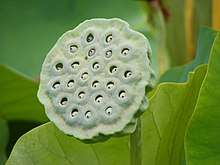trypophobia
English
WOTD – 28 November 2017
Etymology

The holes in the seedheads of lotuses (such as this Nelumbo nucifera) induce trypophobia in some people
From Ancient Greek τρύπα (trúpa, “hole”) + -phobia (from Ancient Greek φόβος (phóbos, “fear, phobia”)), said to have been coined by a blogger from Ireland in 2005.[1]
Pronunciation
- (Received Pronunciation) IPA(key): /ˌtɹɪpəˈfəʊbi.ə/
- (General American) enPR: trĭ'pə-fōʹbē-ə, IPA(key): /ˌtɹɪpəˈfoʊbi.ə/
- Rhymes: -əʊbiə
- Hyphenation: try‧po‧pho‧bia
Noun
trypophobia (uncountable)
- An irrational or obsessive fear of irregular patterns or clusters of small holes, such as those found in honeycombs. [from 2005]
- 2013 October, G[eoff] G. Cole; A[rnold] J. Wilkins, “Fear of Holes”, in Psychological science, volume 24, number 10, DOI:, PMID 23982244, pages 1980–1985:
- Images of lotus seed heads are often reported as inducing trypophobia. Sufferers of trypophobia report that it is the visual percept that is particularly aversive.
-
Related terms
Translations
fear of holes
|
|
References
- “Louise” (23 May 2005), “Trypophobia”, in A Phobia of Holes, Yahoo! GeoCities, archived from the original on 16 March 2009, retrieved 26 September 2017: see Jennifer Abbasi (26 July 2011), “Is Trypophobia a Real Phobia?: We Investigate the Fear of Creepy Clustered Holes”, in Popular Science, archived from the original on 12 September 2017.
Further reading

This article is issued from
Wiktionary.
The text is licensed under Creative
Commons - Attribution - Sharealike.
Additional terms may apply for the media files.